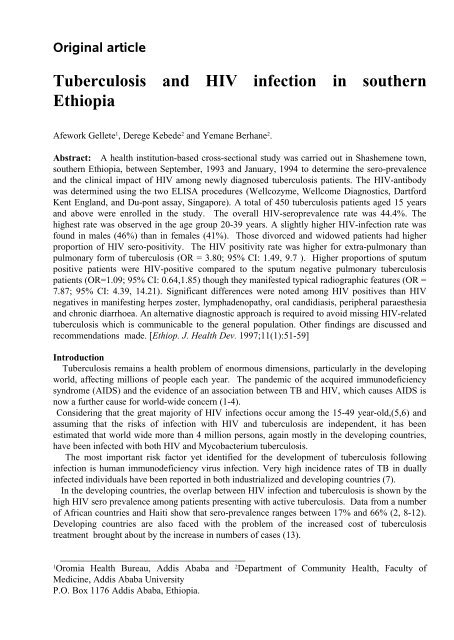Original article - Ethiopian Review
Original article - Ethiopian Review
Original article - Ethiopian Review
- No tags were found...
Create successful ePaper yourself
Turn your PDF publications into a flip-book with our unique Google optimized e-Paper software.
<strong>Original</strong> <strong>article</strong>Tuberculosis and HIV infection in southernEthiopiaAfework Gellete 1 , Derege Kebede 2 and Yemane Berhane 2 .Abstract: A health institution-based cross-sectional study was carried out in Shashemene town,southern Ethiopia, between September, 1993 and January, 1994 to determine the sero-prevalenceand the clinical impact of HIV among newly diagnosed tuberculosis patients. The HIV-antibodywas determined using the two ELISA procedures (Wellcozyme, Wellcome Diagnostics, DartfordKent England, and Du-pont assay, Singapore). A total of 450 tuberculosis patients aged 15 yearsand above were enrolled in the study. The overall HIV-seroprevalence rate was 44.4%. Thehighest rate was observed in the age group 20-39 years. A slightly higher HIV-infection rate wasfound in males (46%) than in females (41%). Those divorced and widowed patients had higherproportion of HIV sero-positivity. The HIV positivity rate was higher for extra-pulmonary thanpulmonary form of tuberculosis (OR = 3.80; 95% CI: 1.49, 9.7 ). Higher proportions of sputumpositive patients were HIV-positive compared to the sputum negative pulmonary tuberculosispatients (OR=1.09; 95% CI: 0.64,1.85) though they manifested typical radiographic features (OR =7.87; 95% CI: 4.39, 14.21). Significant differences were noted among HIV positives than HIVnegatives in manifesting herpes zoster, lymphadenopathy, oral candidiasis, peripheral paraesthesiaand chronic diarrhoea. An alternative diagnostic approach is required to avoid missing HIV-relatedtuberculosis which is communicable to the general population. Other findings are discussed andrecommendations made. [Ethiop. J. Health Dev. 1997;11(1):51-59]IntroductionTuberculosis remains a health problem of enormous dimensions, particularly in the developingworld, affecting millions of people each year. The pandemic of the acquired immunodeficiencysyndrome (AIDS) and the evidence of an association between TB and HIV, which causes AIDS isnow a further cause for world-wide concern (1-4).Considering that the great majority of HIV infections occur among the 15-49 year-old,(5,6) andassuming that the risks of infection with HIV and tuberculosis are independent, it has beenestimated that world wide more than 4 million persons, again mostly in the developing countries,have been infected with both HIV and Mycobacterium tuberculosis.The most important risk factor yet identified for the development of tuberculosis followinginfection is human immunodeficiency virus infection. Very high incidence rates of TB in duallyinfected individuals have been reported in both industrialized and developing countries (7).In the developing countries, the overlap between HIV infection and tuberculosis is shown by thehigh HIV sero prevalence among patients presenting with active tuberculosis. Data from a numberof African countries and Haiti show that sero-prevalence ranges between 17% and 66% (2, 8-12).Developing countries are also faced with the problem of the increased cost of tuberculosistreatment brought about by the increase in numbers of cases (13)._______________________________________1Oromia Health Bureau, Addis Ababa and 2 Department of Community Health, Faculty ofMedicine, Addis Ababa UniversityP.O. Box 1176 Addis Ababa, Ethiopia.




![to read the full report [pdf, Amharic] - Ethiopian Review](https://img.yumpu.com/52737829/1/190x245/to-read-the-full-report-pdf-amharic-ethiopian-review.jpg?quality=85)











